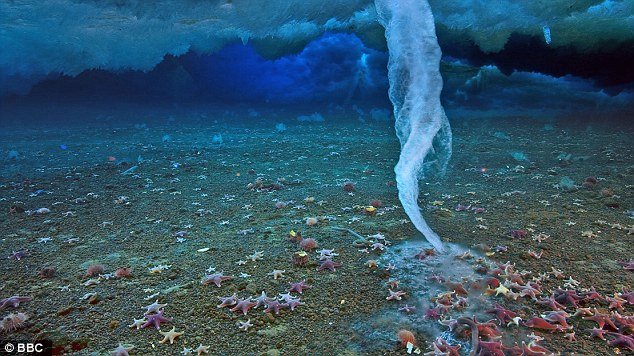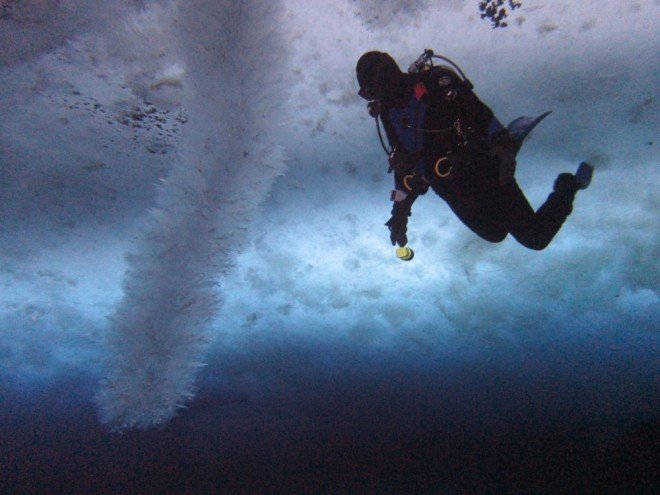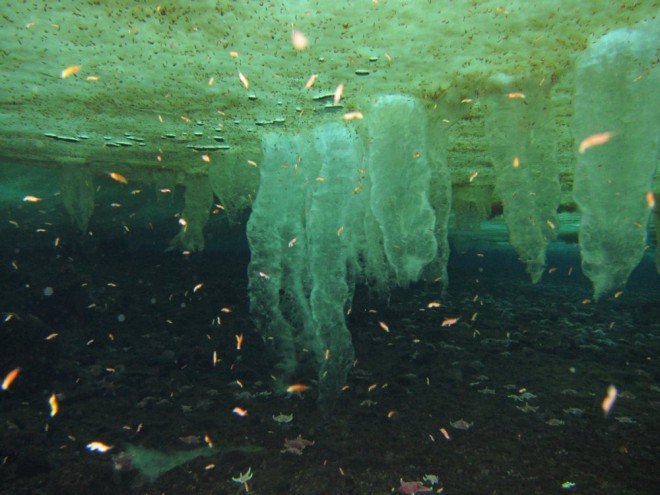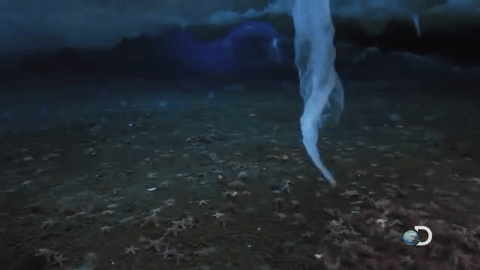
(Image source: dailymail.co.uk)
Welcome to another post on Bizarre Natural Phenomena series! How about diving once again in the cold waters of the Antarctic Ocean? Come on, it's not that cold (I'm lying, it's freezing down there!).
Well, you're sitting around in the bottom of the Antarctic Ocean, chilling (literally) and craving for a treat. Suddenly, as you look up, a big, white popcicle starts coming down towards you! Your eyes open wide and your mouth even wider, but I wouldn't suggest pulling your tongue out and lick this thing as it could easily freeze you badly!

(Image source: wired.com)
What you just witnessed, my friends, is called a brinicle! An icy flow of brine sinking slowly into the cold ocean.
I want that recipe!
Given the fact that sea water freezes in lower temperatures than drinking water, it just needs a lot lower temperatures to turn into ice. In extremely cold temperatures, like the ones in the Arctic and the Antarctic circles, even the sea can freeze. Brinicles form from seawater. Let's follow the process below.
Salt water on the surface of the sea gradually freezes excluding some of its components (salt and ions). This means seawater ice is more pure than the water it comes from. Think of it as a filtering process (so I guess you could use seawater ice as a last resort in a drinking water shortage?). The ice we get is more porous (spongy-like) and the outsiders of this process gather within its cracks. During this process, a cold and dense brine is formed. As density becomes greater and greater, the brine finally makes its way through the cracks and escapes into the sea.

(Image source: wired.com)
Being distinctively colder than the seawater right under the layer of ice, the cold brine down-flow encounters the relatively warmer seawater. Remember, impure water has a lower freezing point, the brine has high concentrations of salt and ions lowering its freezing point tremendously. The seawater it meets has a temperature of about 24.5 °F (-2°C), since brine temperature is a lot lower, seawater that gets in the brine's way starts to freeze around the downward saline stream, forming a descending vent of ice crystals.
In the beginning, this slowly forming icy straw is very delicate and fragile, but as more and more water particles turn into ice crystals, the outer layer becomes thicker and more stable. We now have the perfect insulating layer to prevent our brine stream from diffusing into seawater and warming up. If conditions are favorable, no sea creatures swim past the brinicles to destroy them or strong water currents wash them away, the brinicles can get to the bottom of the sea when it's not a long distance from the surface to the bottom.

(GIF source: mnn.com)
When reaching the bottom, its cold touch freezes everything that gets in its way, whether it be rocks and seaweed or starfish and urchins, anything not fast enough to get out of the way will end up an icy ornament (I guess now you no longer wonder why they called them icicles of death). A brinicle's journey usually ends in a cold, briny pool (usually referred to as "black pools of death") where you may come across numerous dead bodies of unlucky sea creatures that got trapped and died in them.
Could life have been born within it?
Brinicles have been known to scientists since 1960. Being a relatively new discovery, there is still plenty of room for further study. One remarkable theory about them is that a brinicle could have possibly been the "culprit" for life formation! The briny masses show high concentrations of chemical compounds along with the presence of lipids and fats. These can be used as a primitive membrane, necessary to hold life. Within those masses we find acidic and basic components, material that could be used to fuel the formation of more complex structures, and why not DNA. Keep in mind it is just a theory, nothing has been confirmed so far.
Watch this footage and admire how a brinicle slowly forms in the water, captivating life with its freezing cold touch:
The video was recorded in 2011 and it's a 12-hour timelapse covering the formation of a big, 20-feet (6-meter) long brinicle
References
livescience.com
mnn.com
wikipedia.org
thescienceexplorer.com
wired.com

Thank you for reading today's post! I hope it got you excited enough to follow me, @ruth-girl, for more fascinating phenomena!
If nature's weirdness is your thing, you can check some of the previous articles of this series:
10 - The Lava Lake
11 - The Toxic Underwater Lake
12 - Underwater Crop Circles
13 - The Spotted Lake
14 - The Huge Crystals Cave
15 - Ice Brinicles
16 - The Massive Aspen Colony
Interested in science? Please, don't forget to check the @steemstem project, a community-driven project meant to promote well-written, high-quality, STEM-related content (STEM as for Science, Technology, Engineering and Mathematics). Join them in steemit.chat for more information.
And for those engaging with education, @steemiteducation is here to join all steemian educators in their common cause of making our job easier, more effective and more fun!
Finally, the greek community of steemit is here and waiting for you to discover it! Follow the @greek-trail for daily doses of good-quality posts by wonderful writers!
Until my next post,
Steem on, people, and keep smiling!


